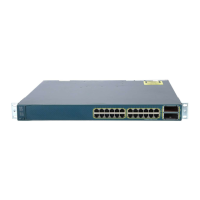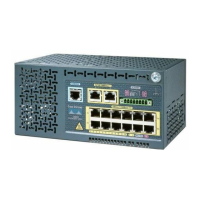5-2
Catalyst 3750 Switch Software Configuration Guide
78-16180-02
Chapter 5 Managing Switch Stacks
Understanding Switch Stacks
The system-level features supported on the stack master are supported on the entire switch stack. If the
switch stack must have switches running both standard multilayer image (SMI) and enhanced multilayer
image (EMI) software, we recommend that a switch running the EMI software be the stack master. EMI
features are unavailable if the stack master is running the SMI software.
Similarly, we recommend that a switch running the cryptographic (that is, supports encryption) version
of the SMI or EMI software be the stack master. Encryption features are unavailable if the stack master
is running the noncryptographic version of the SMI or EMI software.
The stack master contains the saved and running configuration files for the switch stack. The
configuration files include the system-level settings for the switch stack and the interface-level settings
for each stack member. Each stack member has a current copy of these files for back-up purposes.
You manage the switch stack through a single IP address. The IP address is a system-level setting and is
not specific to the stack master or to any other stack member. You can manage the stack through the same
IP address even if you remove the stack master or any other stack member from the stack.
You can use these methods to manage switch stacks:
• Cluster Management Suite (CMS) software through a supported browser session
• Command-line interface (CLI) over a serial connection to the console port of any stack member
• A network management application through the Simple Network Management Protocol (SNMP)
• CiscoWorks network management software
To manage switch stacks, you should understand:
• These concepts on how switch stacks are formed:
–
Switch Stack Membership, page 5-3
–
Stack Master Election and Re-Election, page 5-4
• These concepts on how switch stacks and stack members are configured:
–
Switch Stack Bridge ID and Router MAC Address, page 5-5
–
Stack Member Numbers, page 5-6
–
Stack Member Priority Values, page 5-7
–
Switch Stack Offline Configuration, page 5-7
–
Hardware Compatibility in Switch Stacks, page 5-10
–
Software Compatibility in Switch Stacks, page 5-10
–
Switch Stack Configuration Files, page 5-12
–
Additional Considerations for System-Wide Configuration on Switch Stacks, page 5-13
–
Switch Stack Management Connectivity, page 5-14
–
Switch Stack Configuration Scenarios, page 5-15
Note A switch stack is different from a switch cluster. A switch cluster is a set of switches connected through
their LAN ports, such as the 10/100/1000 ports. For more information about how switch stacks differ
from switch clusters, see the “Switch Clusters and Switch Stacks” section on page 6-14.
